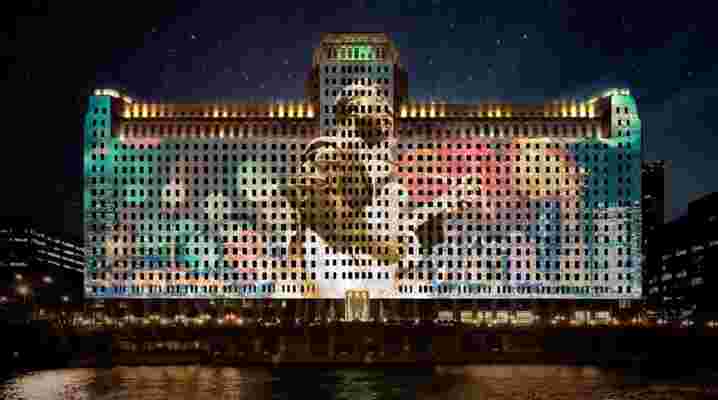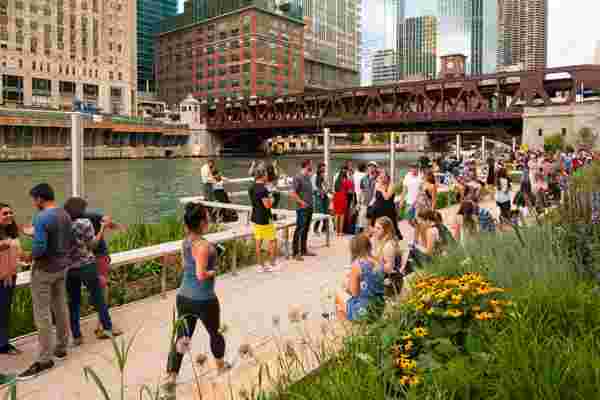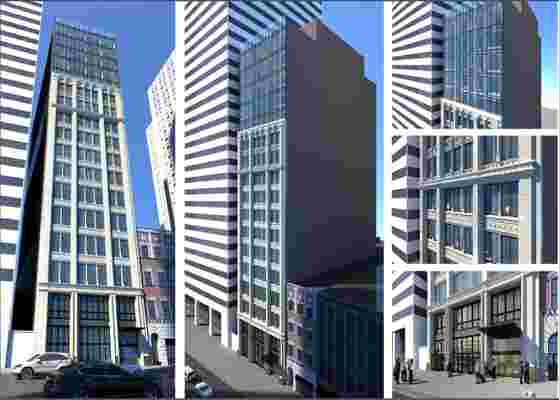On Chicago’s newly developed Chicago Riverwalk, the Windy City has just become the host of the world’s largest permanent digital art installation, projecting giant colorful images onto the riverfront art deco icon Merchandise Mart. Several buildings down, the Chicago Architecture Center has recently opened in its new location, the German modernist Mies van der Rohe’s last constructed masterpiece, anchoring the Chicago Riverwalk as an international architectural destination.
With Mayor Rahm Emanuel’s efforts to turn Chicago’s second waterfront—the first being Lake Michigan—into a gathering space for all, and with prominent architects investing in the city, Chicago is experiencing yet another major architecture boom.

An art projection on the city's famed Merchandise Mart.
“I wanted to make the Chicago River the next recreational park for the city,” Chicago Mayor Rahm Emanuel tells AD . “For the city that grew up with a unique lakefront, the river was not only an afterthought, it wasn’t even in the city’s mind’s eye.”
Emanuel drew inspiration from Paris and Berlin to create the 1.25-mile promenade along the Chicago River.
“You have to create public spaces that have a common way to experience life, and that’s what [the Chicago Riverwalk] has done,” says Emanuel. “It’s led to incredible economic development—billions of dollars have been invested in hotels, restaurants, and bars along the river. [The Chicago Riverwalk] has become a real center point for the city, when six years ago, this wasn’t imaginable.”

The new Chicago Riverwalk.
Aside from the Riverwalk, Chicago has 58 cranes up in the city this year, which is second only to Seattle in the United States.
Under construction are six new mega-skyscrapers, which are 70 stories or higher. Architect Jeanne Gang of Studio Gang is designing the 93-story Vista Tower, which will be the tallest skyscraper in the world built by a woman. Other notable women architects involved in changing Chicago’s skyline are Billie Tsien, the architect designing the Obama Presidential Center, and Carol Ross Barney, who designed the Chicago Riverwalk alongside landscape architect Sasaki.
The city is also building the only low-income housing in the United States with public libraries integrated into the spaces.
“We asked great architects and artists to get involved and use civic pride—they weren’t going to make money on this. This is what we used to do 100 years ago but stopped,” Emanuel comments. “We had 38 architects bid on the three [library and public housing] projects; they want to get involved.”
SOM will design the public housing and library project on the Near West Side, Perkins+Will in West Ridge, and John Ronan Architects in Irving Park.

Renderings of the forthcoming Hotel Julian.
While some architects invest in the new, other architects are investing in the old. The Old Chicago Main Post Office will become an office complex; the long-abandoned Beaux Arts building of the Cook County Hospital will become two Hyatt hotels; and the Atlantic Bank Building will transform into a boutique hotel property, Hotel Julian.
Hotel Julian’s principal architect, David Genc of Hirsch MPG, says, “As Chicago’s building stock of high-rises continues to age, we see there being a continued appetite to repurpose the best of these older structures into new icons of Chicago, connecting the past with the present. The success of cities in the future will rely in part on their ability to adapt to new technology without forgetting what came before them.”
With innovation comes adaptation. Some longer-standing Chicago properties, such as Parisian architecture firm Jean-Paul Viguier et Associés's slender, glimmering white hotel, Sofitel Chicago Miracle Mile, opt to renovate in order to stay fresh in the midst of Chicago’s architecture boom.
The Sofitel designed by Parisian architect Jean-Paul Viguier et Associés.
“We like to think we were at the forefront of this recent boom in envelope-pushing architecture,” Sofitel’s general manager, Matthew Blackmore, notes. “We felt it necessary to refresh ourselves along with the city.”
“Not only is our architecture unique and distinct—that’s the human form—but it’s also against this incredible natural backdrop, Lake Michigan,” says Emanuel. “No place in the world brings you these two distinct features: One is timeless, and one is spaceless.”
RELATED: A Chicago Home That Exudes Elegance with a Rock-and-Roll Edge
